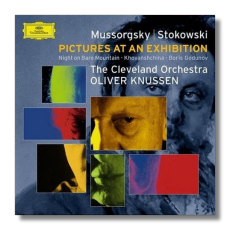
The Internet's Premier Classical Music Source
Related Links
- Mussorgsky Reviews
- Latest Reviews
- More Reviews
-
By Composer
-
Collections
DVD & Blu-ray
Books
Concert Reviews
Articles/Interviews
Software
Audio
Search Amazon
Recommended Links
Site News
 CD Review
CD Review
Modest Mussorgsky

Transcriptions by Leopold Stokowski
- Pictures at an Exhibition (1939)
- "Boris Godunov" Synthesis (1936)
- Entr'acte to "Khovanshchina" (1922?)
- Night on Bare Mountain (1940)
Cleveland Orchestra/Oliver Knussen
Deutsche Grammophon 457646-2
For what it's worth, which may be little, Stokowski was born the year after Mussorgsky died. In a sense, then, this music is 'contemporary' for him.
Leopold Stokowski was a musician first and used conducting as a means of reaching that goal. Another was by writing orchestral transcriptions. His recordings of those works bothered some critics. Stokowski was not the only person who wrote Bach transcriptions, Elgar and Mahler are two names that come to mind at once. Why Stokowski was singled out for criticism is a mystery. Perhaps it is because his personality bothered them and this way they could attack him without seeming to. Of course he wrote many other transcriptions and this disc contains some of his finest.
Ravel made the first and best-known transcription of Mussorgsky's work but, frankly, Stokowski's is better. I am not alone in this opinion; several other writers have put it thus.
Stokowski felt strongly that no one had adequately captured the Russian-ness of Mussorgsky's piano original… Stokowski's orchestration has much bolder contrasts than Ravel's: it is both more subtle and more grandiose and his concept of the orchestration is kaleidoscopic – the opening, which Ravel gives to the brass has, in Stokowski's version, extraordinary shifts of color, with low woodwinds (four flutes in unison!) prominent.
(From the notes by Colin Matthews in the Knussen release.)
Listening to this, I realize that Knu (sorry if I offend… okay, I'm not really) has created, or re-created, the Stokowski "Sound" better than anyone has so far. There are some differences. In the opening of "Pictures" Stokowski emphasizes the violas and cellos, giving matters a darker hue, whereas Knussen brings the violins to the fore. Still, Knu brings out the deep, rich bass line and the timpani are mind-blowing. It occurred to me that he has done this without free bowing (one of the 'things' Stokowski was known for when thinking about HIS Sound… thanks to Ed for providing this information from the composer/conductor). As that sank in I began to think, again, about how it was that Stokowski did create that sound? I listened to his recordings of this piece as part of this learning process. I also listened to Bamert's recordings on Chandos. As I listened to Knu it dawned on me that he imbues the music with a spirit no one else has recreated. It is not just a matter of timings. It must be mentioned, however, that Bamert takes the Ox bit as slow as Giulini in the Ravel transcription (2:40). Knu's Ox times in at exactly the same timing as Stokowski in his stereo recording for Decca (1:57). This is a very important factor because if you use a much slower tempo it is not in tune (ar..ar) with the spirit in Stokowski's transcription. Stokowski portrays the Ox as a strong, heady beast I wouldn't want to tangle with… or even get in its way. The slower speed simply guts the Stokowski transcription. Even more than timings or details, however, Knu maintains a tension in the playing that keeps me on the edge of my seat. At the close of the Pictures I wanted to jump up and scream, "Yes!!! Damn!!!"
Then there is the "relief" as Stokowski put it in an interview. That sense of perspective where the shadows lie. That sense of perspective necessary to make a black-and-white film that is from a whole different planet than the same thing created in color. This is what Knu brings to the music as well. There is a feel of perspective from a fourth dimension… it is like feeling you are literally walking down the halls and looking at the Pictures as at the same time you are listening to the music in the warmth of your study… unstuck in time.
Of the rest of the fare about the same can be said. Knussen brings the Stokowski flair and the deep, rich bass line that is an essential part of The Sound. Listening to these pieces I am constantly sitting-up-and-paying-notice. I smile as I catch a detail here, there and other where, I had not noticed before. I must say that it equals the Maestro's own recordings and, of course, sounds even better. In fact, it brings to mind Stokowski's assertion that some day recordings will sound better than live performances.
Okay, so you already have Bamert's recording of the very same fare on Chandos. Do you need to add to it? If you don't you have no idea what you are missing. It is necessary to have at least three instances before you can really develop a concept. Knu offers playing and sound that is better than Bamert's. That is not to denigrate Bamert's efforts, rather it is more like the fact that the Excellent is the enemy of the Very Good.
Finally, it is good to see that other musicians are appreciating the musician Stokowski. They can look at the music and see that music is more than black marks on white paper but what they see in their mind's ear that this is good music. Knussen conveys this magic more convincingly than Bamert and I feel certain that he could do the same with Sawallisch or any other.
Good stuff… good stuff.
Copyright © 2004, Robert Stumpf II


















